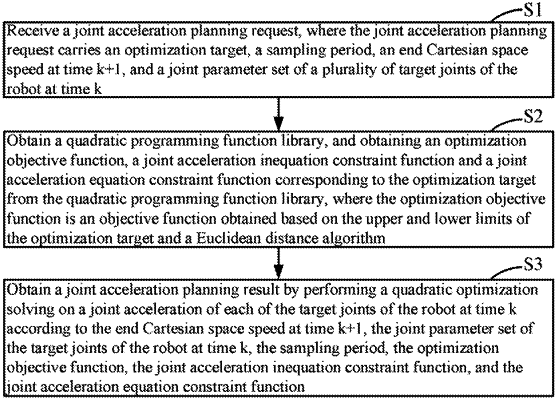| CPC B25J 9/1651 (2013.01) [B25J 9/1607 (2013.01)] | 20 Claims |

|
1. A computer-implemented joint acceleration planning method for a redundant robot, comprising:
receiving a joint acceleration planning request, wherein the joint acceleration planning request carries an optimization target, a sampling period, an end Cartesian space speed at time k+1, and a joint parameter set of a plurality of target joints of the robot at time k;
obtaining a quadratic programming function library, and obtaining an optimization objective function, a joint acceleration inequation constraint function and a joint acceleration equation constraint function corresponding to the optimization target from the quadratic programming function library, wherein the optimization objective function is an objective function obtained based on the upper and lower limits of the optimization target and a Euclidean distance algorithm; and
obtaining a joint acceleration planning result by performing a quadratic optimization solving on a joint acceleration of each of the target joints of the robot at time k according to the end Cartesian space speed at time k+1, the joint parameter set of the target joints of the robot at time k, the sampling period, the optimization objective function, the joint acceleration inequation constraint function, and the joint acceleration equation constraint function;
wherein when the optimization target is a joint speed, the optimization objective function is determined by:
determining the joint speed of the i-th target joint at time k+1 according to the joint speed of the i-th target joint at time k, the joint acceleration of the i-th target joint at time k, and the sampling period;
obtaining a speed Euclidean distance of the i-th target joint at time k+1 by performing a Euclidean distance calculation on the joint speed of the i-th target joint at time k+1 and an average value of upper and lower limits of the joint speed of the i-th target joint;
obtaining a square value of a difference value of the upper and lower limits of the joint speed of the i-th target joint by performing a square calculation on the difference value of the upper and lower limits of the joint speed of the i-th target joint;
obtaining a speed Euclidean distance ratio of the i-th target joint at time k+1 by dividing the speed Euclidean distance of the i-th target joint at time k+1 by the square value of the difference value of the upper and lower limits of the joint speed of the i-th target joint;
obtaining a first objective function by summing the speed Euclidean distance ratios of all the target joints at time k+1; and
obtaining the optimized objective function when the optimization target is the joint speed by performing a minimum value solving on the first objective function.
|